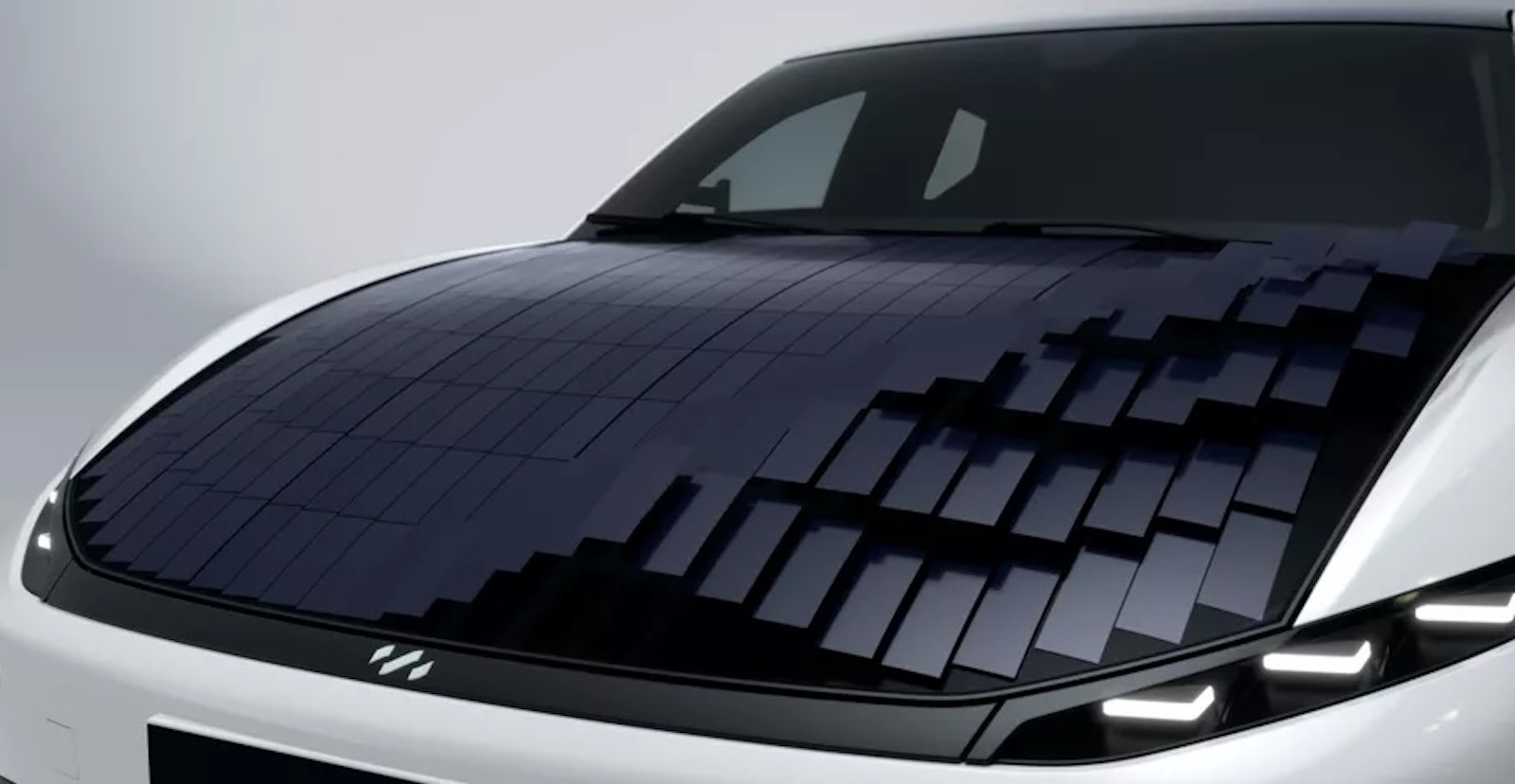Electric Cars In Every Garage, With Solar Panels
Sign up for daily news updates from CleanTechnica on email. Or follow us on Google News!
The idea of outfitting electric cars with solar panels seems reasonable enough, considering that many cars spend most of their time out in the sun. However, the devil is in the details, and those details have already tripped up several startups that promised to bring solarized electric cars to market. That includes the Dutch firm Lightyear, which was touch-and-go for a while, but now the company is back and ready to give it another go.
The Rough & Tumble World Of Solarized Electric Cars
Unlike conventional solar arrays that sit in one place, car-situated solar panels have to put up with a lot of extra stress as the vehicle travels down the road, hitting potholes and other rough patches along the way. That can lead to micro-cracks and other damage. Nevertheless, Lightyear was off to a promising start when it first crossed the CleanTechnica radar several years ago with its eponymous Lightyear electric car outfitted with bespoke rooftop solar panels that conformed to its aerodynamic styling.
Reality hit in the form of an encounter with bankruptcy but Lightyear re-emerged with a refreshed business plan focusing on affordability. The new burst of activity included the announcement of a pre-order of 10,000 solar electric cars from the vehicle leasing firm Arval, a fully owned subsidiary of the leading leading EU and international bank BNP Paribus Group (see more Lightyear solar car background here).
In terms of actually starting production, that announcement put Lightyear ahead of the German firm Sono Motors, which gave up on its Sion solarized car last year. The news also indicated that Lightyear could give the US autocycle startup Aptera a run for the money.
However, that was last year. This year Lightyear introduced another business model. In its most recent iteration, the company has come around to the idea that it can continue life as a manufacturer of photovoltaic systems for electric cars produced by other automakers, instead of trying to do everything itself.
The Lightyear Layer Plan For Solar Electric Cars: Money Talks
Lightyear describes its current “Lightyear Layer” business model as a vehicle-integrated photovoltaics platform providing off-grid charging solutions for electric vehicles. “We aim to help our business customers bring the advantages of solar mobility to a larger audience worldwide and pave the way for solar electric vehicles,” the company states.
That puts Lightyear in competition with other automotive stakeholders dipping into the vehicle-located solar field. For an edge, Lightyear states that its solar panels outperform comparable products in terms of average annual energy yield. The company also notes that its system is a highly adaptable, customizable soup-to-nuts platform for electric cars including power conversion and data in addition to the solar panels.
If money talks — and it often does — Lightyear is on to something. On September 20, the company announced that it has secured a new funding round of more than 10 million euros, its largest round since restarting.
“After a challenging year, these funds ensure the continued manufacturing of our highly efficient on-board solar systems for vehicles, such as solar panels on vehicle rooftops,” Lightyear observed.
Among Lightyear’s investors is the firm Zero Point Holding, which notes that the new business plan “creates a compelling opportunity to maximize the impact of existing and new technologies,” as described by Zero Point founder Clemens Schlettwein.
In a press release announcing the new round of funding, Lightyear reaffirmed its new role as a supplier of systems for electric cars and other vehicles. “Over the past year, numerous valuable lessons were learned that helped guide the decisions to reshape and bring Lightyear to where it is today: from building a solar electric vehicle to making solar electric vehicle technology broadly available,” Lightyear explained.
Solar Electric Cars & Grid Reliability
As for the general idea of adding solar panels to electric cars, that may seem like an unnecessary expense at a time when more renewable energy is available on the grid or from household solar arrays. Still, the convenience of getting a free recharge from renewable energy without having to find a charging station can balance out the additional up-front cost.
The US Department of Energy is also a fan, due to the potential for a national fleet of solar-powered electric vehicles to contribute to overall grid reliability and resilience.
Last year the agency’s Solar Energy Technologies office recapped all the ways that the electric vehicles and solar energy work together. As one key benefit, a solar-charged electric car battery to provide backup power to a home in case of a power outage, which is something that Ford and other automakers are already promoting.
Utilities that offer virtual power plant incentives or other demand-response benefits can also count on solarized electric cars to charge up off-grid, helping to smooth out daytime demand spikes and prevent excess stress on the grid. Off-grid solar charging also enables drivers to fill their battery at any sunny parking spot, which makes the convenience of workplace charging accessible without requiring the installation of expensive new EV charging infrastructure.
SETO also points out that the electricity infrastructure available for new charging stations is already being maxed out in some places, a concern I heard when attending a BMW event in New York this week (I’ll have more on that later in a later post). Off-grid charging by solarized electric cars would help reduce the expense of building new infrastructure, and that would benefit all ratepayers.
The Waiting Is Over, Electric Pickup Truck Edition
Although SETO sees much potential in solarized electric cars, the office sees even more potential in putting solar panels on commercial trucks and trailers. “These vehicles are driven during the day, have large, flat surfaces, and standardized vehicle shapes, all of which makes them promising applications for vehicle-integrated PV,” the agency explains.
Pickup truck drivers who use flat cargo covers can also take a spot in the solarization vanguard. One firm to watch in that area is the Canadian firm Worksport, which has introduced a solarized tonneau cover along with an energy storage package, which is compatible with electric pickup trucks from leading automakers.
Meanwhile, if you’re wondering what happened to Aptera, the on-again, off-again startup is still alive and kicking. Among the latest developments is the conclusion of a successful period of crowdfunding and a hookup with the financial firm US Capital. Over the summer US Capital announced plans for a funding round of up to $60 million, so stay tuned for more on that.
Aptera has also been taking a page out of the Lightyear playbook. Over the summer, the San Diego Business Journal reported that Aptera is exploring the idea of solarizing electric cars from other automakers, leveraging its intellectual property portfolio valued at $130 million. SDBJ lists aviation ground support vehicles, recreational vehicles, and boats among Aptera’s initial targets.
Keep an eye on the electric trailer firm Polydrops, which has hooked up with Aptera to outfit its super-light trailer with an ambitously-sized 1,300 kilowatt solar array.
Follow me via LinkTree, or @tinamcasey on Threads, LinkedIn, and Instagram.
Photo (cropped): The idea of putting solar panels on electric cars is gaining more traction, both as a charging convenience and as a contribution to grid reliability and resilience (courtesy of Lightyear).

Have a tip for CleanTechnica? Want to advertise? Want to suggest a guest for our CleanTech Talk podcast? Contact us here.
Latest CleanTechnica.TV Videos

Advertisement
CleanTechnica uses affiliate links. See our policy here.
CleanTechnica’s Comment Policy
